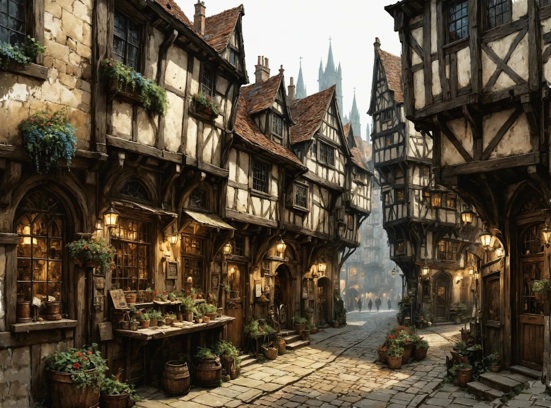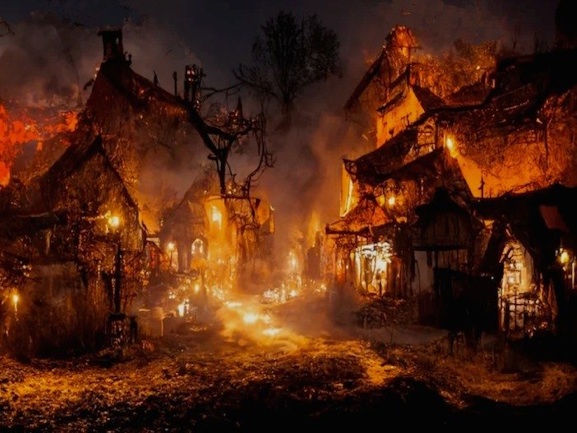SLHS: Fires




Disclaimer
Whilst some care has been taken to check externally linked websites no responsibility is offered nor implied for the suitability, legality or reliability of content therein.
Statements are made here to the best of our knowledge. However no statement here should be regarded as irrefutable fact. Please contact us if you consider otherwise.
Mediaeval Buildings Were Tinderboxes
As towns and villages throughout the world developed man relied heavily on timber framed dwellings with rooves made of similar material. Of course as more buildings were built more forests were felled and less and less timber remained - yet populations continued to increase. Buildings were heated by fires, initially open hearths but as time progressed heat resistant fireplaces were incorporated.
In order to reduce the total demand for wood wattle and daub were used for the walls and straw or reeds were used for the rooves. Most of Stratford’s early houses were of this timber-framed design and they incorporated brick hearths and chimneys. The facilities became quite developed often incorporating spit-roasting irons and adjustable hooks from which to hang cooking pots.
Obviously the fires burnt timber that could not be used for construction until the discovery of coal and its widespread delivery to those who could afford it.
Further Information..
-
Superb booklet detailing (download 1Mb): FiresInStratfordInThe16-17Centuries_WarwickshireHistory_©StephenPorter_1976.pdf
-
Stratfire Project..
-
The Stratford Society and Historic England have embarked on a major project to discover which houses, and to what extent, these houses were burnt down during Stratford’s catastrophic fires.
-
For a full outline and updates on progress see: Stratford Society: Stratfire
● These items have aspects that uniquely contribute to national or world history.

To return to Master page click on ‘Streets’ above.
-
● Full
-
● Partial
-
● None
-
Theatres ●




Of course fires were most notable in the largest of English towns. London experienced great many with huge death tolls. The entire city was infamously burn out in 1666. Boudica and the Iceni razed the city to the ground in 60AD and there were the two notable fires in 675 and 989. The first St Paul's Cathedral was burnt to the ground during the fire of 1087.
All along buildings with straw or reed rooves were actually tinderboxes waiting to catch fire. In the winter the risks were less but in the summer just one spark from a fire could set a roof alight and then that burning house would catch nearby houses alight depending on the strength of the wind at the time.
As everywhere else Stratford suffered small fires frequently in the summer months. However the fires in the following years were particularly devastating: 1594, 1595, 1614, 1641.
During the years leading to 1614 the summers had been particularly long and dry and because the central part of the town had had particularly large fires just 20 years before the town was at high alert. Unfortunately that summer occasioned some very strong winds and the town experienced a fire storm that was unstoppable as it swept through the buildings.
-
“the flame and smoake thereof is soe greate, and soe violent that noe man is able to come neere those howses or to stand in the wynd to defend the fayer tyled howses.”
Wooden Buildings Burn
Stratford’s Fires
Actions To Prevent Fires
Obviously fires start by a combination of:
-
•dryness of the weather
-
•domestic hearth fires generating sparks
-
•the vulnerability of the roof materials to fire in the first place
Last update: 31/10/2024
Created: 13/04/2024
Stratford’s Fire Storms
Nevertheless accidents still happened and Stratford suffered numerous fires including these four great devastations as a result. There’s no point in repeating the material but below is a document detailing these fires and the fragility of the life that people had to cling on to. We highly recommend it.
See booklet: Fires In Stratford In The 16-17 Centuries (below)
The Curfew Bell Solution
As has been discussed if the weather is dry then sparks, that get swept up the chimney by its draught, will linger for quite some time in the air above it and then float downwards still glowing. Even putting a metal gauze across the top of the chimney will only reduce this incidence and not completely negate it.
Commonly people would be wary of allowing clusters of sparks by preventing log on a fire to say drop as it burns through. Likewise they would be greatly vigilant to not allow such a log to fall out of the hearth and roll across the floor and so ignite any materials nearby. People learnt not to leave fires unattended for too long.
However at night, when people go to sleep, attention like that would be impossible. With this consideration it became law that all domestic fires had to be extinguished after a certain time in the evening. Nationally this was set at 8pm and most towns, including Stratford, had a bell to announce this.
See webpage: Stratford’s Curfew Bell (shortcut above)
The Permanent Solution
Building Regulations
Finally, although at great cost to individuals, town councils across the land introduced new regulations making it mandatory for buildings in towns to have a tile or slate roof. Whilst this significantly reduced the number of fires starting if a house did indeed catch fire then this didn’t reduce fires from being passed, from one building to the next, below roof level (see image immediately above).
In order to prevent this entire buildings would have to be moved or demolished and nobody was going to entertain that and so legislation was very difficult to enact. Sadly these fires did happen or were even caused during war time (eg the fire bombing of Dresden during WW2). For this very reason, by ‘natural wastage’ there now aren’t many towns left with, what we see as picturesque, narrow mediaeval streets -exceptions are Canterbury, Chester, Shrewsbury, York, Wells etc.
Throughout the centre of the town.
